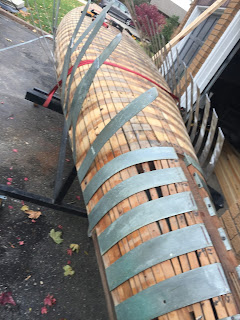The view heading to Peterborough, with an 18' Maine guide canoe on the roof.
Collected in 2015, and found here
http://blog.ravenwoodcanoes.com/2015/07/maine-guide-canoe-continued.html
a rare example of the transitional early period from birchbark building to wood canvas, form built canoes. Too well preserved to give a cosmetic restoration, and too old to press into service paddling, it would be best kept in a collection where it could be interpreted and eventually displayed.
Collected in 2015, and found here
http://blog.ravenwoodcanoes.com/2015/07/maine-guide-canoe-continued.html
a rare example of the transitional early period from birchbark building to wood canvas, form built canoes. Too well preserved to give a cosmetic restoration, and too old to press into service paddling, it would be best kept in a collection where it could be interpreted and eventually displayed.
The decision was made to offer it to the Canoe Museum, and they were keen to acquire it
Down off the racks, covered in years worth of sawdust
Typical of early Maine canoe construction, and reminiscent of early birch bark construction.
The heavy tumblehome continues along the sheerline, all the way to the decks
Top and side caps missing, but still retains original seat caning.
Showing the full ends and lower midships that were typical of a lot of guide canoe builders such as EM White and others.
Rails extend beyond stem tips, and long narrow decks
Very fine, narrow entry in the ends.
Arriving at the museum in Peterborough mid week; who wouldnt want a day off school
Yes, there is a gift shop
Jeremy having a quick look at some to the details
Nice early shape, perfectly suited to carrying a load.
Currently there is no real representation of early form built, canvas canoes from the Eastern United States, where builders such as EH Gerrish are credited with developing cedar canvas construction, the next evolution after birchbark building.
Yes, of course we managed to make sure the roof wasnt empty for the return trip home, with another stray coming back. The concept of one in, one out is upheld, at least for the time being....


















































 "
"


